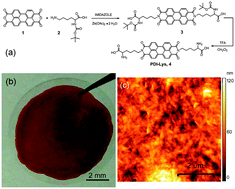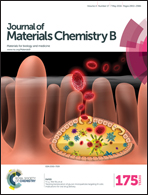A self-assembled lysinated perylene diimide film as a multifunctional material for neural interfacing†
Abstract
We report the design, synthesis and structure–property investigation of a new perylene diimide material (PDI-Lys) bearing lysine end substituents. Water processed films of PDI-Lys were prepared and their self-assembly, morphology and electrical properties in both inert and air environments were theoretically and experimentally investigated. With the aim of evaluating the potential of PDI-Lys as a biocompatible and functional neural interface for organic bioelectronic applications, its electrochemical impedance as well as the adhesion and viability properties of primary neurons on the PDI-Lys films were studied. By combining theoretical calculations and electrical measurements we show that due to conversion between neutral and zwitterionic anions, the PDI-Lys film conductivity increased significantly upon passing from air to an inert atmosphere, reaching a maximum value of 6.3 S m−1. We also show that the PDI-Lys film allows neural cell adhesion and neuron differentiation and decreases up to 5 times the electrode/solution impedance in comparison to a naked gold electrode. The present study introduces an innovative, water processable conductive film usable in organic electronics and as a putative neural interface.



 Please wait while we load your content...
Please wait while we load your content...